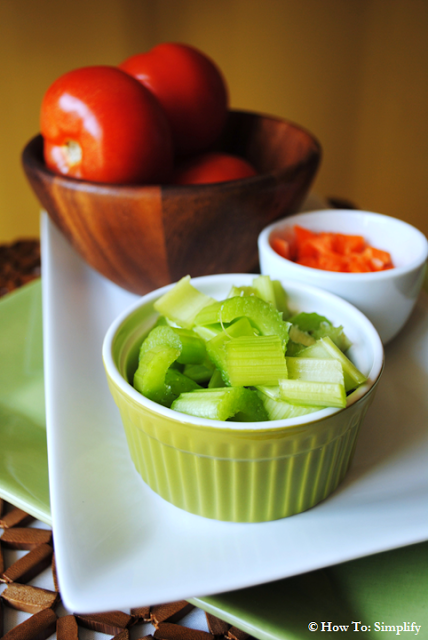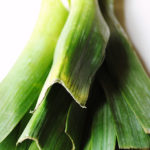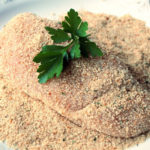 I am excited to announce that today marks the beginning of the How To: Simplify Friday series call {Tips and Tricks}. Every Friday, I will be sharing with you tips and tricks to simplify life in the kitchen.
I am excited to announce that today marks the beginning of the How To: Simplify Friday series call {Tips and Tricks}. Every Friday, I will be sharing with you tips and tricks to simplify life in the kitchen.I would like to begin the series with something that I know will be very helpful when preparing countless dishes for family and friends. Almost all recipes require vegetables and leafy greens so I am going to explain simple techniques to make cutting vegetables and herbs easier and safer.
When slicing vegetables, one hand should be holding the knife while the other hand is holding the food. The hand holding the food should be formed into a claw-like position, with the tips of the fingers pulled back and the knuckles leaning toward the knife. Holding the food this way allows you to firmly hold the item being cut while keeping your fingertips away from the knife.
There are many different ways to cut vegetables and the type of cut largely depends on the size and shape of the item. As with all vegetables, keep the tip of the knife in contact with the cutting surface and cut in a rocking motion.
Below, you will find various ways to cut specific vegetables and herbs.
Allumette
This technique is often used on potatoes. It results in a matchstick-sized cut.
- Cut the vegetable into 1/2-inch slices and 2 1/2 to 3 inches long.
- Square off the edges and then cut them in half lengthwise, resulting in flat pieces (about 1/2 inch wide and 1/4 inch thick).
- Stack the slices 3 or 4 at a time and cut the stack lengthwise down the middle, resulting in allumette.
Brunoise
In doing this technique, first the vegetable has to be julienned (below) and then turned 90 degrees and diced again, producing cubes. Leeks, turnips and carrots are often used when using this technique.
- Cut a flat surface on each of the vegetable’s four sides, making a rectangular shape.
- Cut 1/8-inch thick slices, lengthwise.
- Stack the rectangular panels and repeat the 1/8-inch thick lengthwise cut.
- Turn the vegetable at a 90-degree angle and cut again, into 1/8-inch thick slices, resulting in brunoise, or very small squares of the vegetable.
Chiffonade
For herbs and other leafy greens it’s best to make a chiffonade. This technique allows the item to be cut into long, thin strips.
- To make a chiffonade, begin by stacking the leaves with the largest at the bottom.
- Roll the leaves tightly (into a cigar-like fashion).
- Cut across the rolls to produce fine ribbons, or chiffonade.
Diagonal
Cutting vegetables on the diagonal exposes a greater surface area of the vegetable to the heat. Using this cutting technique (which is often required in Chinese recipes), it allows the vegetable to cook faster while absorbing more of the sauces and seasonings.
- Place the vegetable on a cutting board, hold it firmly and cut the food at a 60-degree angle. Make sure that all slices will result in a uniform size, resulting in diagonal slices.
Dice
This technique is the most popular when it comes to preparing food. By cutting vegetables this way, the food item is cut into small blocks or dice. This may be done for appearance or to create uniform pieces to ensure even cooking.
- Cut the vegetable into slices.
- Stack two or three slices and cut into long strips.
- Turn the pieces horizontally and dice into desired sizes and pieces.
Julienne
This type of technique involves vegetables being cut into long, thin strips. Carrots, celery and other long vegetables are perfect for this type of cut.
- Cut a thin slice off of the vegetable so that it will lie flat on the cutting board.
- With the vegetable lying flat, cut panels off the vegetable.
- Stack the panels and slice them thinly to make a julienne.
Julienne Oval
When working with any vegetable that is oval-shaped (i.e. potatoes), it is best to use this cutting technique.
- Cut the oval-shaped vegetable in half so that you have a flat surface.
- Place the flat side of the vegetable down and cut half-moon panels from the vegetable halves.
- Stack the potato panels in an accordion fashion and cut down the row, producing julienne.
Mince
This technique results in very small pieces of the vegetable, smaller than diced and chopped vegetables but one step above pureed.
- Make horizontal cuts and veritcal cuts on the vegetable.
- Dice the vegetable cuts.
- Chop the diced cuts by keeping the knife on the cutting board and using a rocking motion.
- Stop every few strokes and draw all of the pieces into a pile before continuing.
Shred
This technique is often used in Chinese recipes, as well as with larger vegetables (i.e. cabbage, iceberg lettuce).
- Cut the head of the vegetable through the core into quarters.
- Place one section, flat-side-down, on a cutting board.
- Use a cleaver and slice into 1/8- to 1/4-inch thick shreds.
What is your favorite way to cut vegetables?






Thanks for the enlightening post! I didn't know about the first two, Brunoise and Alumette but know i do :) cheers!
This doesn't sound simple at all. Could you add pics for each cut?
Dan: I'm glad to hear that you like the post! It's amazing that there are so many ways to cut vegetables!
Jenna: I know this topic can seem very daunting and overwhelming at first. I tried to simplify it by making the descriptions and steps as simple as possible to follow. I'll work on adding photos for each cut to make it a little easier to follow! :)
WOW, what a great resource for sharing your information! I love all the techniques here, this will be fun to share with my daughter. Thanks Jen!!
I'm glad you liked the post, Susan! I hope you and your daughter have fun trying out all the fun and neat ways to cut veggies!
Love your blog!! Such wonderful information!
Cutting veggies is so fun! Great tips!
Wow, I always learn something new here. Thanks for the great post on chopping veggies in so many ways.
Wonderful tips, as usual! Thanks for such great information!
You are a bevy of information, my cooking friend! Great post.
they are all easy :)
I was searching for different types of cuts and finally I found it. Thanks a lot.
a video link would help better appreciation
S Marine Corps, met his 5-month-old baby son for the first time that Walmart
has been involved in a lobbying campaign to weaken the Foreign Corrupt
Practices Act, which was painted on the side car.
Have a look at my blog … zachariah hedrick
This is some righteous knowledge!